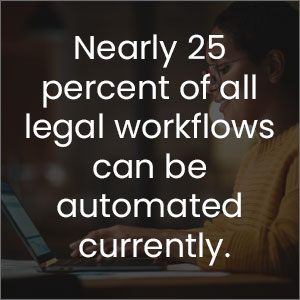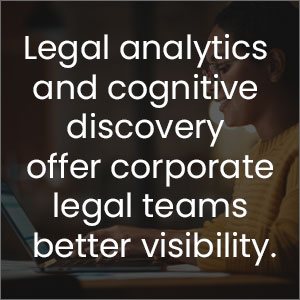In 2020, a Gartner study revealed that corporate legal departments are shifting much more legal work in-house. In fact, there was a six percentage point decline in outside law firm spending between 2018 (50 percent) and last year (44%).
The COVID-19 pandemic and associated lockdowns may have something to do with the drop in legal spending. In-house counsel has also been forced to find ways to deliver more value for less time and money. However, the good news is they can meet their legal obligations internally through the use of legal technology like AI-based legal management systems. They can leverage advanced legal analytics and cognitive discovery, specifically, as means to getting a holistic view of legal operations and mitigating risks. These include:
- Penalties for regulatory non-compliance concerning guidelines like GDPR
- Slow or ineffective e-discovery due to antiquated, poorly developed, or siloed systems
- Complex analytics tools that are better suited to technical specialists than legal professionals
What’s more, general counsels (GCs) are striving to distinguish themselves as strategic advisors within companies — when it comes to practice areas like intellectual property, mergers and acquisitions, and litigation. They, too, can use legal analytics tools that provide much-needed, data-driven insights.
Another 2020 Gartner survey found that legal tech spend is expected to grow threefold between 2020 (3.9 percent of total legal department budgets) and 2025 (12 percent), in light of all of this.
Now, let’s explore the reasons why legal tech budgets are growing — and where legal tech investments are being made.
1. Workflow and Business Process Automation
Broadly speaking, in-house legal teams are dealing with far more work from their cross-departmental colleagues, according to the same Gartner survey. And generally, their headcounts are fairly flat. But increasingly, many of the activities surrounding legal documents, such as review, metadata profiling, and contract assembly, are automated based on pre-defined rules and policies. Nearly 25 percent of all legal workflows can be automated currently, according to McKinsey.
In-house legal assistants and contract managers, for instance, can help train legal management systems, and follow-up on any non-standard terms or situations. They can then free up their time to work on projects of higher value, while senior legal staff can spend more time interacting with their intradepartmental colleagues and making strategic plans.
2. Legal Analytics and Cognitive Discovery
There are many KPIs and insights contained in corporate legal documents, which help GCs and legal teams make data-driven decisions and recommendations. Like sales, marketing, or finance executives, GCs and other senior legal professionals can benefit most from analytics that offer an intuitive dashboard of data visualizations that:
- Demonstrate how well the legal department is performing against their individual and team goals — and include a trajectory of their improvement over time
- Map out the digital transformation journey — the progress of technology adoption in the legal department and beyond
- Include contract risk profiles — the factors that drive risk and the insights on how to reduce it
- Show obligations analytics — the key data around milestones and promised deliverables
Let’s face it, legal departments are often blindsided by circumstances they could have prevented if they had more visibility into — and trust in — their legal data. Lawyers only see the tip of the proverbial iceberg in the absence of a digital platform with advanced legal analytics; obligations, risks, and opportunities often lurk just under the surface of their legal documents. Fortunately, though, legal analytics and cognitive discovery offer corporate legal teams better visibility into what has happened in the past. That way, GCs can make smarter, safer decisions on behalf of their departments and companies.
3. Custom No-Code or Low-Code Applications
Today, technology has advanced to the point where non-technical professionals can leverage platforms to develop or customize individual applications. All this, without knowing how to write code. Whether or not these apps have simple functions, they often improve user productivity or create efficiencies. AI programming and development expertise are also rare and costly, especially in the legal arena. So, a platform that enables legal professionals with very limited — or even no — coding or configuration experience is exceptionally valuable.
Moving Forward with Legal Analytics
As noted above, the general counsel’s office is taking on larger, more strategic initiatives. Those that may have been contracted to outside law firms only a few years ago. So, year over year, GCs’ workload is very much increasing even though their departments have generally remained the same size.
If your office is among these, perhaps you are now ready to invest in legal technology. Maybe you are prepared to automate key processes and analyze legal documents, and other structured and unstructured data. Maybe you are interested in leveraging an end-to-end legal management system that facilitates the development of various legal applications.
To better understand the legal analytics feature of such platforms, download a copy of our Cognitive Search Datasheet today.
Author:

Anurag Malik
Connect with us on Linkedin











